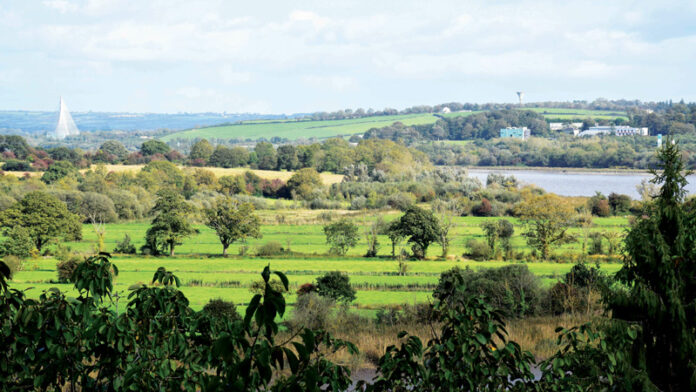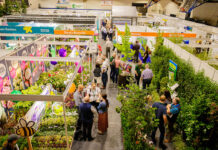Of the 70 participants who gathered last 28/29 September for the National Landscape Forum (NLF) 2023, 30 electrified the room with their diverse presentations.
In Waterford’s beautiful Mount Congreve House and Gardens, the crescendo of happy, energy-laden conversation at the coffee and lunch breaks was its own verdict on each day’s deliberations, which were reinforced by enthusiastic, constructive feedback.
A huge concern for everyone at the NLF is Ireland’s ailing National Landscape Strategy, and how to reignite it.
The Irish government launched its National Landscape Strategy 2015-2025 (NLS) back in 2015. The strategy was intended to deliver a well-rounded, citizen-involved integrated process with regard to holistic landscape protection, management and planning.
The NLS is central to our implementation of the European Landscape Convention (ELC) and compliance with various EU environmental directives. Yet this crucial high-level policy framework, whose aim is to support and protect the Irish landscape, appears to have stalled in 2018.
At the forum, Willy Cumming gave a clear explanation of the building blocks of the National Landscape Strategy. In my own presentation, I offered the millennial time-line of evolving landscape-awareness and appreciation of landscape value that explains the ‘deep landscape’ reasoning behind the struggle for a National Landscape Strategy.
Perhaps the greatest achievement of NLF 2023 is that it located the official in the Department of Housing, Local Government and Heritage (DHLGH) who is charged with responsibility for the implementation of the National Landscape Strategy. (NLF 2023 organisers, Landscape Alliance Ireland [LAI], only received this information three days before the forum.)
As a result, Daniel Sinnott – Principal Officer, Built Heritage, DHLGH – bravely accepted an invitation to participate in NLF 23 at very short notice. In his presentation, he briefly outlined the current uncertain future of Ireland’s National Landscape Strategy.
KNOWLEDGE & INSPIRATION
Presentations at the NLF ranged widely. Pere Sala inspired us with the achievements of the Landscape Observatory of Catalonia, a government landscape advisory body doing great work.
Keeping it local, Eamonn McEneaney provided a sweeping overview of the evolution of Waterford’s urban landscape; Dr Emily Shakespeare gave an assessment of ‘deep place’ via Kilrossanty’s local landscape biographies; Ray Sinnott presented a blow by blow account of the difficulties faced in achieving the recent ‘big house’ reinvention of Mount Congreve House and Gardens; and Des Gunning elaborately explained where precisely we, the forum participants, were located on the day.
Ruth Minogue and Laura Kearney brought us up to speed on how our fragmented landscape character assessment process might find a way out of its current tangled maze. David Eagar asked the hard question as to whether we in Ireland have yet to agree on what constitutes a ‘balanced’ landscape. Dr Amy Strecker presented the challenges involved in landscape, heritage and Irish Law.
The subject of energy and landscape was highlighted at the NLF through Jack Workman’s wake-up call on the seemingly almost impossible planning task of addressing the green energy transition; Dr Karen Ray’s gentle but forceful tale of the turbines that might have waved over the tranquil, spiritual waters of Gougane Barra; and Sinead Mercier’s consideration of energy, legislation and landscape strategy.
The soft colour landscape palette of island, bog and boreen were explored in depth by Paula Barrett. Bernadette Guest reported from the coal-face on landscape in the planning process.
The critical role of trees was reflected at the forum by Yvonne Grace’s discussion of ‘non-native’ trees that may yet become common and ancient our warmer future landscape; and Aidan ffrench’s philosophy of tree care and connection, with parks being linked to form urban forests.
Dr Jane Russell O’Connor explored how people see – and sometimes don’t see – seascapes and mountainscapes, while Dr Una Fitzpatrick told of the difficult tale of biodiversity that we may see or not see in our future landscape. Karen Foley made the case that evolving landscapes left to take shape without design oversight risk being shapeless and biodiverse-less.
Conversations with fields and their farmers was the subject of Dr Sharon O’Brien’s talk. John Briggs asked have we reached a stage where science risks researching the soul out of landscape; and Catherine Keena presented hedgerow management through a ‘virtual walk’. Dominic Walsh explained landscape in a regional context, and Sarah Prosser described the potential for people, place and local economies to be weaved into a landscape tapestry.
Forum participants were treated to a virtual boat trip with Andrew Doherty along the tidal highways and byways of the Rivers Suir, Nore and Barrow, and Gretta McCarron presented her ‘written in water’ river catchment approach, linking communities and landscapes into a coherent tracery from spring to sea.
Gary Graham and Michal Slawski brought attention to the potential for suburban and city landscapes, with their respective presentations on gardens large and small, and the upcoming Green Cities conference.
Other NLF 2023 successes included The Irish Landscape Institute 30th Anniversary Exhibition, on view at the South East Technological University’s Granary Campus, Merchants Quay, Waterford City. Luke Currall organised an art and landscape evening event at the Waterford Gallery of Art, where a full house enjoyed presentations from artists Carmel Cleary, Paula Barrett, Caoilfhionn Hanton; artists/poets Molly, Mike & Samuel; and my own narrative contribution.
Capping the NLF outreach, the sixth class pupils of Gaelscoil Philib Barún in Tramore were invited to illustrate their understanding of landscape. The resulting images, exhibited at the forum, provided a fascinating insight into how our next generation perceives landscape today.
This whistle-stop overview of the NLF fails to do justice to the quality, erudition and commitment of the 30 or so speakers. LAI hopes to make the presentations available in due course.
CLARION CALL
Our landscape will continue to change, as it has always done, but probably more rapidly than ever before.
The National Landscape Strategy 2015-2025 was intended to provide an integrated framework across central and local government to inform and guide a sustainable process of landscape protection, management and planning, which would safeguard landscape quality whilst accommodating profound change.
However, in terms of snakes and ladders, the good governance ladder we ascended as a civic society with the launch of NLS 2015-2025 turned out to be a short one. Since then, we’ve slid down a very long bad governance snake.
We are not quite back at the start of the board, but the task ahead is now even more formidable than in 2015. I’m too old to be playing this game of chance. The Irish state can’t afford to play such games either.
Substantial resources must be invested into the NLS as a matter of extreme urgency.
The Irish government owns neither the Irish landscape nor the National Landscape Strategy; yet it has the power to decide whether they live or die. Our politicians and others who bemoan delays in our planning and development process would do well to ask questions about the state’s performance in delivering the necessary infrastructure for an efficient, effective, balanced and sustainable process, before they try to shift the blame onto frustrated citizens.
During NLF 2023, the LAI carried out a survey among participants on how they viewed the priority status of the six NLS objectives and their 18 associated actions. From 28 returns, the majority indicated that all six objectives were of high priority. While this was not a large poll and it was an interested audience, it does represent a call for comprehensive implementation action.
The recent National Landscape Forum demonstrated, as it has done since 1995, that the landscape players, stakeholders and concerned citizens of this state value their landscape.
These people and organisations are more than willing to work with the authorities to ensure the Irish landscape’s responsible protection, management and planning.










